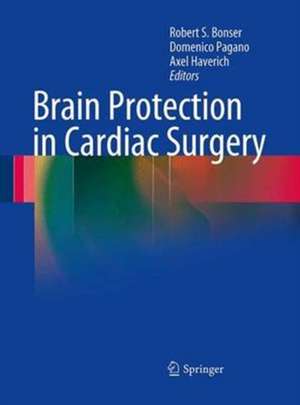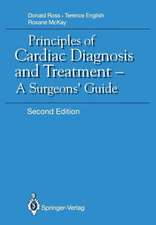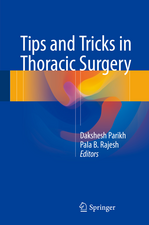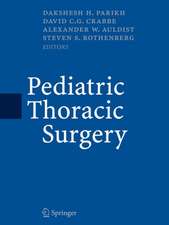Brain Protection in Cardiac Surgery
Editat de Robert S. Bonser, Domenico Pagano, Axel Haverichen Limba Engleză Paperback – 23 aug 2016
| Toate formatele și edițiile | Preț | Express |
|---|---|---|
| Paperback (1) | 715.90 lei 38-44 zile | |
| SPRINGER LONDON – 23 aug 2016 | 715.90 lei 38-44 zile | |
| Hardback (1) | 982.18 lei 38-44 zile | |
| SPRINGER LONDON – 7 ian 2011 | 982.18 lei 38-44 zile |
Preț: 715.90 lei
Preț vechi: 753.57 lei
-5% Nou
Puncte Express: 1074
Preț estimativ în valută:
136.98€ • 143.41$ • 113.35£
136.98€ • 143.41$ • 113.35£
Carte tipărită la comandă
Livrare economică 01-07 aprilie
Preluare comenzi: 021 569.72.76
Specificații
ISBN-13: 9781447168331
ISBN-10: 144716833X
Pagini: 246
Ilustrații: XV, 246 p.
Dimensiuni: 193 x 260 mm
Ediția:Softcover reprint of the original 1st ed. 2011
Editura: SPRINGER LONDON
Colecția Springer
Locul publicării:London, United Kingdom
ISBN-10: 144716833X
Pagini: 246
Ilustrații: XV, 246 p.
Dimensiuni: 193 x 260 mm
Ediția:Softcover reprint of the original 1st ed. 2011
Editura: SPRINGER LONDON
Colecția Springer
Locul publicării:London, United Kingdom
Cuprins
Brain injury of cardiac surgery.-Cerebral physiology & metabolism.-Molecular & biochemical basis.Future interventions.-Cardiopulmonary bypass circuit.-Neurological sequelae.-Incidence, pre-operative risk factors & long-term outcome.-Neuropathology.-Inflammatory response.-Post-surgical impact.-Assessment of brain injury.-Utility of neuropsychometric analysis.-Pitfalls of neuropsychometric assessment & alternative investigative approaches.-Imaging of the brain.-Current techniques of emboli detection.-Intra-operative brain monitoring.-Design of brain protection studies in the C21st.-Reducing brain injury in cardiac surgery.-Temperature & brain protection.-Studies of non-pharmacological interventions.-Pharmacological studies to reduce brain injury following cardiac surgery.-Off-pump & on-pump coronary artery surgery & the brain.-Experimental basis & clinical studies of brain protection in paediatric heart surgery.-Experimental basis & clinical studies of brain protection in aortic arch surgery.-The future.
Recenzii
From the reviews:
“This book addresses the current understanding of the neurocognitive issues associated with the surgery. … is directed at healthcare professionals specializing in cardiac surgery - practicing surgeons and anesthesiologists, residents and fellows, intensive care physicians, neurologists and neurointensivists, researchers and other practitioners. … Select tables, graphs, illustrations, and imaging studies support the information. … a unique synopsis of the state of knowledge on this subject. It is an invaluable educational resource for a wide range of professionals whose careers are related to cardiac surgery.” (Zdravka Zafirova, Doody’s Review Service, December, 2011)
“This book addresses the current understanding of the neurocognitive issues associated with the surgery. … is directed at healthcare professionals specializing in cardiac surgery - practicing surgeons and anesthesiologists, residents and fellows, intensive care physicians, neurologists and neurointensivists, researchers and other practitioners. … Select tables, graphs, illustrations, and imaging studies support the information. … a unique synopsis of the state of knowledge on this subject. It is an invaluable educational resource for a wide range of professionals whose careers are related to cardiac surgery.” (Zdravka Zafirova, Doody’s Review Service, December, 2011)
Textul de pe ultima copertă
Brain injury remains one of the most dreaded complications of cardiac surgery. The range of injury is broad; while a stroke may be easily defined and diagnosed, more subtle injuries most definitely occur. There remains debate as to how these are diagnosed and there is a lack of standard definitions allowing inter-study comparison. If we are to have confidence in strategies that may reduce brain injury, we need to have confidence in the end-points used to define that injury. We need to better understand the phenomena associated with neuropsychometric testing; we need to fully elucidate the relationship between structural brain injury, embolism counting, and surrogate biomarkers; and we need an improved understanding of the clinical significance of abnormalities detected on postoperative magnetic resonance imaging.Brain Protection in Cardiac Surgery presents a detailed background of studies of neurological morbidity and neuroprotection from a range of experts in the field of neuroprotection, providing a detailed reference for clinicians in the field. The Editors have detailed connections between the different strands of injury — be it the pathology, the imaging, the clinical and cognitive examination, potential biomarkers — and have then provided summary reports of treatment strategies that may reduce such injury. As we look to the future, the design of studies attempting to reduce such injury becomes increasingly important and this book provides the fundamental background information to fuel interest, initiate novel prevention and therapeutic strategies, and inform the investigator how to develop and design their research study.
Caracteristici
Cardiac surgery textbooks are large, cumbersome and do not keep up with the pace of developments. Smaller more updateable monographs are the future for effective dissemination of information Complete and thorough review of the management of cardiac surgery and the effects on the brain and brain circulation Increased knowledge will assist the surgeon to choose the best procedure or combination of procedures in each case to ensure that risks do not outweigh benefits
























